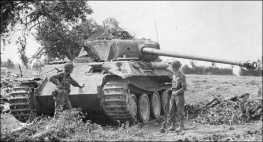
An unusually idyllic view of the landings: the LCTS have come close to shore on calm seas with no German opposition. This photograph was not taken on the Normandy coasts on June 6, in NNW force 6 winds, but in England, during a large-scale rehearsal. Contents page image: British Sherman crews waiting to embark. Shoreham and Portsmouth were the main embarkation ports for the British, while the Americans could be found farther west, notably at Portland, which served the 1st U.S. Infantry Division, and Torquay and Dartmouth, which served the 4th U.S. Infantry Division. (IWM H 38986) Contents page map: August 6, 1944, HQ Twelfth Army Group situation map. (Library of Congress, Geography and Map Division)
CIS0004
Print Edition: ISBN 978-1-61200-6079
Digital Edition: ISBN 978-1-61200-6086
Kindle Edition: ISBN 978-1-61200-6086
This book is published in cooperation with and under license from Sophia Histoire & Collections. Originally published in French as Militaria Hors-Serie No 52, Histoire & Collections 2004
Typeset, design and additional material Casemate Publishers 2018 Translation by Hannah McAdams
Design by Paul Hewitt, Battlefield Design
Color illustrations by Jean Restayn Histoire & Collections
Infographics by Jean-Marie Mongin Histoire & Collections
Photo retouching and separations by Remy Spezzano
Additional text by Chris Cocks
CASEMATE PUBLISHERS (US)
Telephone (610) 853-9131
Fax (610) 853-9146
Email:
www.casematepublishers.com
CASEMATE PUBLISHERS (UK)
Telephone (01865) 241249 Fax (01865) 794449
Email:
www.casematepublishers.co.uk
Timeline of Events
For more than two years, Stalin had been pressing the Western Allies to open a new front on the European mainland to relieve the pressure on the beleaguered USSR. Finally, the tide turned as the Red Army fought the German Sixth Army to destruction in a brutal campaign of attrition, at Stalingrad. Preceded by the July/August 1943 battle of Kursk, the largest tank battle in history, the British victory at El Alamein and Operation Torch , the American landings in North Africa, were sideshows. However Operation Overlord , the massive amphibious landings on the Normandy coast in the summer of 1944, changed that emphatically.
Allied Armored Divisions in Normandy
The Allied armies that landed in Normandy in June 1944 were coalitions of several countries that, for historical or circumstantial reasons, found themselves under the influence of one or other of the two Anglo-Saxon powers.
Thus, the Canadians who landed in France did so within divisions based entirely on the British model, which was perfectly logical for a Commonwealth country. In view of the circumstances, it was equally normal that the 1st Polish Armoured Division was of the British model, since it was in England that the Polish combatants sought refuge after the disastrous collapse of Poland in September 1939, and the fall of France the following June.

Final preparations before the invasion. Tank crews wonder where to store their gear. Most tanks were given nicknames, though only oneBachelor Boys on the tank on leftis visible. (IWM AP 21515)
The 2nd French Armored Division was formed in North Africa from elements of Leclercs mobile column. It was the United States that provided all its matriel, as was the case for most French divisions formed in French North Africa after 1943. As such, it is no surprise that the division was organized according to the American model.
There were thus two main types of armored divisions in the invasion force commanded by General Eisenhower. Yet neither the American nor the British army was completely homogenous in the composition of their armored units.
In the American camp, two large-scale reorganizations saw the creation of the divisions thereafter known as heavy in 1942; their light counterparts followed in 1943. Examples of heavy tanks (that came to include medium tanks) were the M4 Sherman and M26 Pershing, while the M3 Stuart and M24 Chaffee were common light examples. Of the six armored divisions that fought in Normandy, two were heavy and four were light. American tank destroyers (such as the M18 Hellcat) and self-propelled assault guns were also to play a crucial role in American armored units.

The strength of the American economy is revealed in this shot, which is not even a propaganda image. Note that armor plating added in England has been partially welded over the American markings. (IWM AP 16294)
British tank doctrine was divided into two simple tank classifications: one group of tanks would accompany the infantry, known as the infantry tank (originating from the First World War); and secondly, cruiser tanks that would exploit the gains or breakthroughs made by the infantry and their accompanying infantry tanks. Cruiser tanks were more lightly armored and therefore faster than the infantry counterpart and would more commonly be found in an armored division, whereas an infantry tank was found in a tank brigade.
In the British camp, the main component of the armored arm was not the division, but the brigade. In principle, each division comprised one armored brigade. Yet 15 armored brigades landed in Normandy, for only six divisions. Eight independent brigades also came ashore, to provide reinforcements as either infantry or armored divisions; making up the numbers was the 79th Armoured Division, with special equipment to facilitate the landings and which was unlike the other armored divisions in terms of its organization: it had an additional tank brigade that did not take part in the fighting.
These four standard types of Allied armored unitsAmerican heavy and light armored divisions, British armored brigades and divisionswill be examined in the following pages; the case of the 79th Armoured Division will be addressed separately.
The Heavy Armored Division
In September 1939, the American army had no armored divisions whatsoever. The first two were only officially formed about a month after France surrenderedon July 15, 1940, at Fort Knox and Fort Benning respectively. Without going into the minutiae of the organizational changes over the next two years, it can be stated that the standard formula consisted of an armored brigade made up of three tank regiments (two light, one medium), an artillery regiment, an infantry regiment, and a reconnaissance battalion: in total, around 368 tanks strong.




















